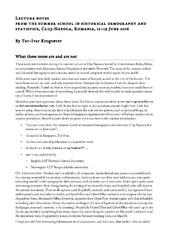Buying and Borrowing Books: Book Consumption In Late Nineteenth-Century Sweden
Permanent link
https://hdl.handle.net/10037/17586Date
2017-07-09Type
Journal articleTidsskriftartikkel
Peer reviewed
Author
Hansen, Poul Henning GustafAbstract
Who read what in the late nineteenth century Swedish society? What books were available in the bookshops and the libraries, and what books were the most popular? This study aims to offer preliminary answers to questions like these, based on sales’ and borrowers’ ledgers from three of the most common types of literary institutions of the time; a parish library, a bookshop, and a commercial lending library.
By the end of the nineteenth century, a dynamic book market was developing in Sweden, where almost everyone could access books in one way or another. The reading public was largely divided into two groups: those who borrowed books and those who bought them. Different institutions catered to different sections of society and the dividing line between the urban and rural areas was significant. This study shows that different sub-groups of readers had different literary preferences. Contemporary writers were popular among the well-educated customers, while the labourers and farmers preferred the writings of an earlier generation of authors, such as Victor Hugo and Alexandre Dumas. Men and women also seemed to favour different genres with men preferring adventure stories, while women readers preferred “tendency novels” and books concerning women’s emancipation. This study of surviving ledgers and receipts from the parish library in Munka-Ljungby, Gumpert’s bookshop in Gothenburg, and Sjöblom’s commercial lending library in Lund reveals interesting patterns of book consumption in nineteenth-century Sweden, as well as how readers’ literary tastes changed over time. Qui lisait quoi dans la société suédoise de la fin du dix-neuvième siècle? Quels livres étaient disponibles dans les librairies et les bibliothèques? Quels titres étaient les plus populaires? En se basant sur les registres et les archives de trois des institutions littéraires les plus populaires de l’époque, à savoir une bibliothèque paroissiale, une librairie et une bibliothèque prêteuse, l’auteur de cette étude propose des réponses préliminaires à de telles questions. À la fin du dix-neuvième siècle, un marché du livre dynamique était en plein essor en Suède. Il était alors possible pour tous d’avoir accès, d’une façon ou d’une autre, à des livres. Le lectorat était, grosso modo, divisé en deux groupes : ceux qui empruntaient des livres et ceux qui les achetaient. Différentes institutions répondaient alors aux besoins des groupes et des classes sociales. Qui plus est, l’écart entre les régions urbaines et rurales était considérable. Par cette étude, l’auteur montre que les différents sous-groupes de lecteurs d’alors avaient des préférences littéraires distinctes. Ainsi, les écrivains contemporains étaient populaires auprès de la frange instruite de la société, tandis que les ouvriers et les agriculteurs préféraient les écrits d’auteurs plus anciens, notamment ceux de Victor Hugo et d’Alexandre Dumas. De plus, les hommes comme les femmes accordaient leur préférence à des genres distincts : alors que les premiers privilégiaient les récits d’aventures, ces dernières, pour leur part, lisaient plutôt des romans engagés faisant la promotion d’une cause, quelle qu’elle soit, ainsi que des livres relatifs à l’émancipation des femmes.
Publisher
The Bibliographical Society of CanadaCitation
Hansen HH. Buying and Borrowing Books: Book Consumption In Late Nineteenth-Century Sweden. Papers of the Bibliographical Society of Canada / Cahiers de la Société bibliographique du Canada. 2016;54(1-2):121-153Metadata
Show full item record
Copyright 2016 The Author(s)
Related items
Showing items related by title, author, creator and subject.
-
Lecture notes from the summer school in historical demography and statistics, Cluj-Napoca, Romania, 12–19 June 2016
Krogsæter, Tor-Ivar (Lecture; Forelesning, 2016-06-19) -
Folkemordet i Rwanda - Voldens brutalitet og sivile aktørers deltagelse
Kolstad, Charlotte Renland (Master thesis; Mastergradsoppgave, 2014-05-15)I 1994 ble rundt 800 000 mennesker drept i et lite sentralafrikansk land, størrelsen på landet kan sammenlignes med Troms fylke i Norge. Hendelsen er kjent som folkemordet i Rwanda. I senere tid har det blitt utgitt et relativt bredt spekter av litteratur på feltet, hvor forskere har hatt forskjellige ståsteder som har resultert i ulike synsvinklinger. Prosjektet tar for seg sentrale oppfatninger ... -
Kvinner i sovjetisk og russisk krigsfilm - offer og moralske førebilete
Høgetveit, Åsne Øysteinsdotter (Master thesis; Mastergradsoppgave, 2014-05-16)Oppgåva undersøker korleis kvinnelege soldatar vert framstilt i filmane A zori zdes’ tikhie (Rostotskij 1972) og Leningrad (Buravskij 2007). Om lag ein million kvinner tenestegjorde i dei sovjetiske styrkane under andre verdskrigen. Kvinners krigsdeltaking gjekk langt utover dei tradisjonelle kvinneoppgåvene som helsepersonell og innom administrasjon: Kvinnelege soldatar var skarpskyttarar, pilotar, ...


 English
English norsk
norsk


